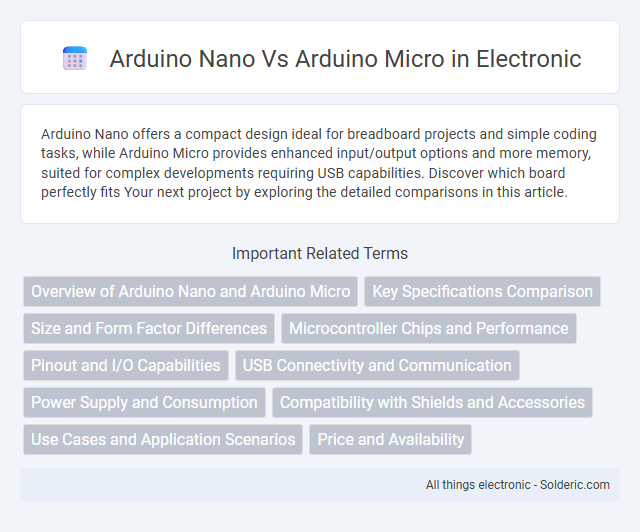Arduino Nano offers a compact design ideal for breadboard projects and simple coding tasks, while Arduino Micro provides enhanced input/output options and more memory, suited for complex developments requiring USB capabilities. Discover which board perfectly fits Your next project by exploring the detailed comparisons in this article.
Comparison Table
| Feature | Arduino Nano | Arduino Micro |
|---|---|---|
| Microcontroller | ATmega328P | ATmega32U4 |
| Operating Voltage | 5V | 5V |
| Input Voltage (recommended) | 7-12V | 7-12V |
| Flash Memory | 32 KB (ATmega328P) with 2 KB used by bootloader | 32 KB (ATmega32U4) with 4 KB used by bootloader |
| SRAM | 2 KB | 2.5 KB |
| EEPROM | 1 KB | 1 KB |
| Clock Speed | 16 MHz | 16 MHz |
| Digital I/O Pins | 14 (6 PWM) | 20 (7 PWM) |
| Analog Input Pins | 8 | 12 |
| USB Interface | Mini-B USB via FTDI chip | Micro USB native |
| Size | 45 x 18 mm | 48 x 18 mm |
| Unique Features | Compact size, standard ATmega328P | Native USB capable, supports HID, integrated USB controller |
Overview of Arduino Nano and Arduino Micro
Arduino Nano features a compact design ideal for breadboard projects, equipped with an ATmega328P microcontroller offering 14 digital I/O pins and 8 analog inputs. Arduino Micro utilizes the ATmega32U4 processor, facilitating native USB communication with 20 digital I/O pins and 12 analog inputs, suitable for more complex tasks requiring direct USB interfacing. Choosing between the two depends on your project's size constraints and USB connectivity needs.
Key Specifications Comparison
The Arduino Nano features an ATmega328P microcontroller with 32KB of flash memory, 2KB of SRAM, and operates at 16 MHz, while the Arduino Micro uses an ATmega32U4 microcontroller with 32KB flash, 2.5KB SRAM, and also runs at 16 MHz. Both boards offer similar digital and analog input/output pins; however, the Micro includes native USB communication capabilities due to the ATmega32U4 chip, making it ideal for USB HID projects. Your choice between the two depends on the need for USB support and package size, where the Nano is more compact and breadboard-friendly.
Size and Form Factor Differences
The Arduino Nano measures approximately 18 x 45 mm, making it one of the smallest Arduino boards, perfect for compact projects with limited space. The Arduino Micro is slightly larger at 18 x 48 mm but offers a more rectangular shape, which suits applications requiring a thinner profile. Your choice between the two depends on the spatial constraints and layout preferences of your electronic design.
Microcontroller Chips and Performance
The Arduino Nano is powered by the ATmega328P microcontroller, running at 16 MHz with 32 KB of flash memory, making it efficient for basic to intermediate projects. The Arduino Micro uses the ATmega32U4 microcontroller, also at 16 MHz but featuring 32 KB of flash memory and built-in USB communication, which enhances its versatility for complex USB-related tasks. Your choice depends on whether you need integrated USB capabilities, as the Micro offers more advanced performance for HID projects compared to the Nano's simpler design.
Pinout and I/O Capabilities
The Arduino Nano features 22 I/O pins, including 14 digital pins and 8 analog inputs, making it ideal for compact projects requiring moderate connectivity. The Arduino Micro offers 20 I/O pins, with 12 digital and 7 analog inputs, plus native USB support for advanced communication options. Your choice between these boards depends on the specific pinout layout and I/O requirements of your project for optimal functionality.
USB Connectivity and Communication
The Arduino Nano and Arduino Micro both offer USB connectivity, but the Micro features a native USB port with built-in USB Human Interface Device (HID) support, enabling it to emulate devices like keyboards and mice. In contrast, the Arduino Nano uses a USB-to-serial converter chip, which limits its USB communication capabilities primarily to serial data transfer. Your choice depends on whether you need advanced USB communication features or simple serial connectivity for your project.
Power Supply and Consumption
The Arduino Nano operates at 5V and can be powered via USB or an external 7-12V power source through its VIN pin, drawing approximately 19 mA during active operation. In contrast, the Arduino Micro also runs at 5V but features a more efficient power consumption profile, typically around 20 mA, with the ability to enter low-power sleep modes to extend battery life. Choosing between the two depends on your project's power constraints, with the Micro offering slightly better options for energy-efficient applications.
Compatibility with Shields and Accessories
Arduino Nano and Arduino Micro share similarities in compatibility with many standard shields and accessories due to their compact form factors; however, the Arduino Micro offers greater flexibility with its native USB support, enhancing integration with USB-based peripherals. Nano's smaller size limits some shield compatibility, requiring careful selection of accessories tailored for its pin arrangement. Your choice should consider the specific shield and accessory requirements of your project to ensure seamless connectivity and functionality.
Use Cases and Application Scenarios
Arduino Nano excels in compact projects requiring minimal space like wearable devices, portable sensors, and small robotics due to its small footprint and USB connectivity. Arduino Micro is preferred in applications needing advanced input/output capabilities such as custom keyboards, HID devices, and complex control systems because of its ATmega32U4 microcontroller with built-in USB functionality. Both boards suit prototyping and embedded systems, but Arduino Micro's enhanced I/O support makes it ideal for interactive and human-interface projects.
Price and Availability
Arduino Nano generally offers a lower price point and is widely available from numerous online retailers and electronics stores, making it an affordable choice for budget-conscious projects. Arduino Micro tends to be slightly more expensive due to its enhanced features but remains accessible through official Arduino distributors and specialty suppliers. Your decision between the two may depend on balancing cost considerations with the specific availability in your region.
Arduino Nano vs Arduino Micro Infographic

 solderic.com
solderic.com